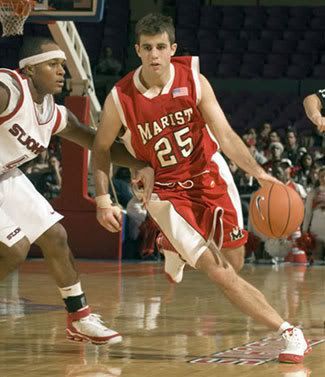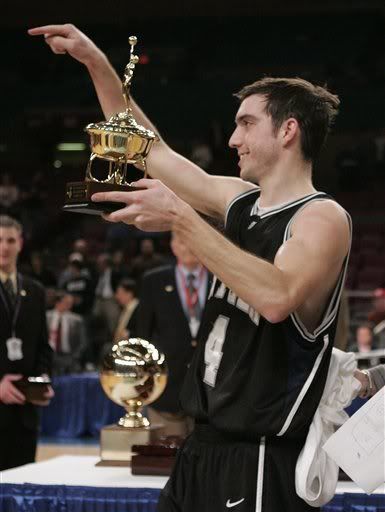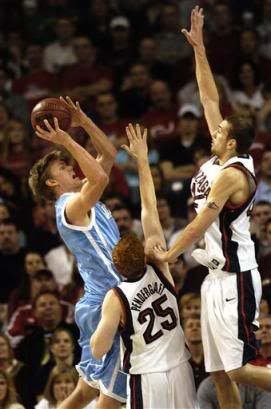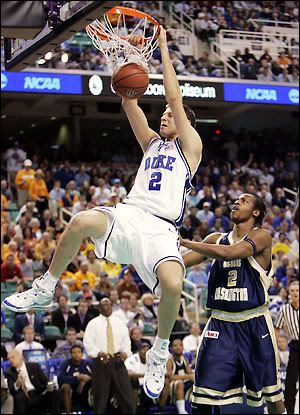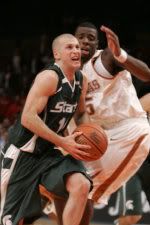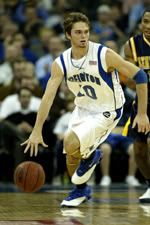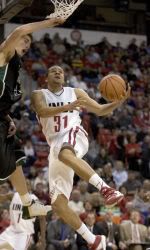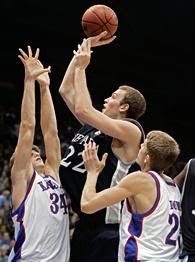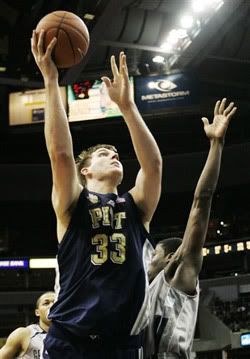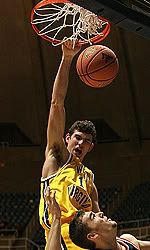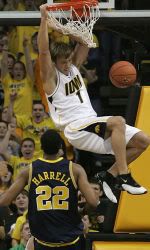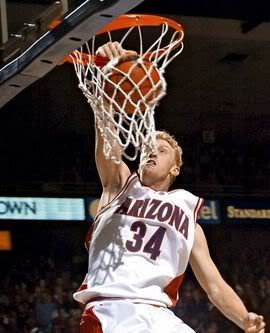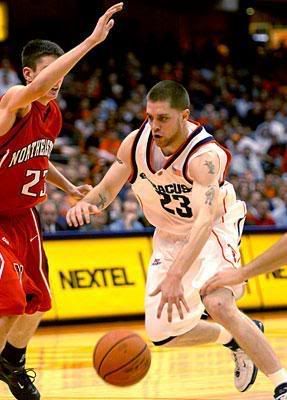Jimmy Chitwood
Hall of Famer
After a couple of weeks of the college basketball season, I thought I'd chime in with my two cents on who is playing the best ball, the freshman who have impressed me so far, and who are the most athletic guys I've seen play.
First, I'll offer my thoughts on my All-American teams. I'm putting together two, because there are two distinct styles that are played, both requiring different types of players and, obviously, each will have guys who dominate that style. It's been a tremendous year so far for white guys, so it's tougher than usual to whittle down the numbers. But a team can only start five players, regardless of the roster's talent, so I've put together my two AA starting lineups. My rosters are unusual. They aren't exclusively stocked by upper classmen, nor are they gauged by their NBA potential, which so many AA teams are. Rather, they're based on who I think is the best college player.
The first is the full court, up-tempo lineup. It is unusual, as it is made up of two short, old guards who don't dunk and three intriguing young big men who do.
Point guard: Jared Jordan Marist, Sr. 6-2, 182. The collegiate version of Steve Nash, Jordan led the nation last year in assists, and is atop that category this year. Nobody in the college game dissects a defense like Jared. Much like Nash, he is criticized for not being an explosive leaper or being the quickest cat in the gym, but just like Nash he routinely destroys "superior afaletes" who try to guard him. A superbly conditioned athlete, Jordan was second in the nation in minutes played a year ago, and will likely be near the top of the rankings again this season (see his performance in the Old Spice Tournament where he played back-to-back 40 minute games in two days). He's also a consistent triple-double threat, despite his "lack of athleticism," and was honored as the tournament's MOP after averaging 20.7 points, 9.0 assists, and 6.3 rebounds while leading Marist to a third-place finish.
Two guard: A.J. Graves Butler, Jr. 6-1, 155. Inside his rail-thin body beats the heart of a sharp-shooting assassin. Graves is the main reason the Butler Bulldogs have gone from an afterthought in the Horizon League to cracking the Top 20. Already this season, Graves has led the Bulldogs to wins over Notre Dame, Indiana, Tennessee, and my beloved Gonzaga, en route to a pre-season NIT Championship. After scoring 26 in the title game, Graves who was the Tourney MVP, hit for 26 against Kent State in a double overtime win on Saturday (Nov. 25) at Kent State. He added five assists and two steals, while committing just one turnover in 48 minutes of action. The sharp shooter is averaging nearly 20 points a game.
Forward: Josh Heytvelt Gonzaga, Soph. 6-11, 238. Heytvelt has emerged as the man in Spokane. Incredibly athletic, Heytvelt (who reportedly has a 40-inch vertical) is already making people take note of Gonzaga despite all the question marks coming into the year. A dominant force in the paint on both ends of the floor, the high-flyer has a formidable skill set for a player his size. At 6-11 he has range on his jumper out to the 3-point line, and unlike many perimeter playing bigs, he's not afraid of eating glass. He averages over 7 boards a game to go with his 17+ points on 54% shooting. His most notable game came when he outplayed Carolina's Tyler Hansbrough in Madison Square Garden, going for 19 points, 8 boards, and 4 blocked shots.
Forward: Josh McRoberts Duke, Soph. 6-10, 240. A point-power forward? McRoberts could be such a man; he's challenging for the Duke lead in assists and routinely runs their offense from the perimeter. His ball handling skills are unmatched by any player his size in the nation. An above the rim player on both ends, Josh's dunks are a staple on Sportscenter, but more importantly he is averaging over 2 blocked shots per game, while snagging nearly 7 boards. On offense, he has a good mid-range game, but his strength is attacking the bucket. So far this season he has been too unselfish, if such a thing is possible, but is still averaging nearly 11 points per.
Center: Tyler Hansbrough North Carolina, Soph. 6-9, 245. How often is your center your shortest frontline player? When it's Hansbrough, it doesn't matter. He is a beast in the paint. Unlike many of today's power people who fall in love with the 3-point line, Tyler knows where to do his damage: in the paint. Perhaps the most physically intimidating player in the college game, Hansbrough fills up a stat sheet while working in the lane, but he runs the floor as good or better than most guards. Averaging nearly 21 points and 9 rebounds per game, Tyler is a legitimate choice for national POY honors.
My half court team is stacked with big men who eat glass and dominate from 18 feet-in, and two experienced guards who are tough, intelligent, and can flat-out shoot the ball. Free throw shooting is a must, because this team will rapidly rack up fouls on the defense, so I've taken care of that as well.
Point guard: Drew Neitzel Michigan State, Jr. 6-0, 180. The leader of an unheralded MSU team that has started off the season a surprising 7-1 (albeit against a weak schedule), including an upset over Texas, Neitzel has put the young Spartans on his back. A role-player as a gritty, hard-nosed point guard in years past, Drew has shown the ability to score both off the dribble and from 3-point range and create for his teammates. Asked to shoulder most of the decision-making burden this year by coach Izzo, Neitzel has proven sufficient to the task. Currently leading the Spartans in scoring while shooting 50% from the floor and 91% from the free throw line, Neitzel won the College Hoops Classic MVP and was recently named Big Ten co-player of the week.
Shooting guard: Nate Funk Creighton, Sr. 6-3, 195. The only player from the Missouri Valley Conference to get pre-season AA consideration as well as being named the MVC pre-season POY, Funk is possibly the best shooter in college basketball today. Creighton has only played 3 games so far, but I'm feeling the Funk until he proves me wrong.
Forward: Jason Smith Colorado State, Jr. 7-0, 230. Center size with small forward agility, Smith has pro scouts drooling despite his debilitating skin condition. First-team all Mountain West as a sophomore, Smith has upped his play significantly this season. Averaging a double-double (16.6 points and 10.4 boards) and nearly 2 and a half blocks per game, he's on pace to win conference MVP honors despite playing on a lackluster CSU team.
Power forward: Nick Fazekas Nevada, Sr. 6-11, 240. Expected to win his third straight WAC POY award, Fazekas is the only player in the nation currently in the top five in both points-per-game (25.0) and rebounds per (14.8 which leads the nation). Long and highly skilled, Fazekas is yet another in the long line of fantastic basketball players who don't jump out of the gym. A big man who can shoot, Fazekas doesn't get much national exposure, but that doesn't mean he can't play.
Center: Aaron Gray Pittsburgh, Sr. 7-0, 270. The only player in the Big East to average a double-double a year ago, Gray is one of only a handful of true centers in the collegiate game. Expected to be the conference POY this season, Gray came back to achieve his goal of leading Pitt to the Sweet 16. A soft touch out to 15 feet, Gray provides a difficult match-up with his strength, size, and skill.
High flyers who are under the radar:
Joe Alexander, West Virginia, Soph. wing; Adam Haluska, Iowa, Sr. wing, Eric Devendorf, Syracuse, Soph. wing;
Freshmen to watch:
Chase Budinger, Arizona, wing
Matt Bouldin, Gonzaga, combo guard
Eric Hayes, Maryland, point guard
Ryan Anderson, Cal, power forward
Spencer Hawes, Washington, center
Check-your-breath All Defense team: these guys get in your face all game long...
Wes Miller, North Carolina, Sr. guard
Bryan Mullins, Southern Illinois, Soph. guard
Mike Nardi, Villanova, Sr. guard
Dane Bradshaw, Tennessee, Sr. guard/forward
Steven Hill, Arkansas, Jr. center
Edited by: Jimmy Chitwood
First, I'll offer my thoughts on my All-American teams. I'm putting together two, because there are two distinct styles that are played, both requiring different types of players and, obviously, each will have guys who dominate that style. It's been a tremendous year so far for white guys, so it's tougher than usual to whittle down the numbers. But a team can only start five players, regardless of the roster's talent, so I've put together my two AA starting lineups. My rosters are unusual. They aren't exclusively stocked by upper classmen, nor are they gauged by their NBA potential, which so many AA teams are. Rather, they're based on who I think is the best college player.
The first is the full court, up-tempo lineup. It is unusual, as it is made up of two short, old guards who don't dunk and three intriguing young big men who do.
Point guard: Jared Jordan Marist, Sr. 6-2, 182. The collegiate version of Steve Nash, Jordan led the nation last year in assists, and is atop that category this year. Nobody in the college game dissects a defense like Jared. Much like Nash, he is criticized for not being an explosive leaper or being the quickest cat in the gym, but just like Nash he routinely destroys "superior afaletes" who try to guard him. A superbly conditioned athlete, Jordan was second in the nation in minutes played a year ago, and will likely be near the top of the rankings again this season (see his performance in the Old Spice Tournament where he played back-to-back 40 minute games in two days). He's also a consistent triple-double threat, despite his "lack of athleticism," and was honored as the tournament's MOP after averaging 20.7 points, 9.0 assists, and 6.3 rebounds while leading Marist to a third-place finish.
Two guard: A.J. Graves Butler, Jr. 6-1, 155. Inside his rail-thin body beats the heart of a sharp-shooting assassin. Graves is the main reason the Butler Bulldogs have gone from an afterthought in the Horizon League to cracking the Top 20. Already this season, Graves has led the Bulldogs to wins over Notre Dame, Indiana, Tennessee, and my beloved Gonzaga, en route to a pre-season NIT Championship. After scoring 26 in the title game, Graves who was the Tourney MVP, hit for 26 against Kent State in a double overtime win on Saturday (Nov. 25) at Kent State. He added five assists and two steals, while committing just one turnover in 48 minutes of action. The sharp shooter is averaging nearly 20 points a game.
Forward: Josh Heytvelt Gonzaga, Soph. 6-11, 238. Heytvelt has emerged as the man in Spokane. Incredibly athletic, Heytvelt (who reportedly has a 40-inch vertical) is already making people take note of Gonzaga despite all the question marks coming into the year. A dominant force in the paint on both ends of the floor, the high-flyer has a formidable skill set for a player his size. At 6-11 he has range on his jumper out to the 3-point line, and unlike many perimeter playing bigs, he's not afraid of eating glass. He averages over 7 boards a game to go with his 17+ points on 54% shooting. His most notable game came when he outplayed Carolina's Tyler Hansbrough in Madison Square Garden, going for 19 points, 8 boards, and 4 blocked shots.
Forward: Josh McRoberts Duke, Soph. 6-10, 240. A point-power forward? McRoberts could be such a man; he's challenging for the Duke lead in assists and routinely runs their offense from the perimeter. His ball handling skills are unmatched by any player his size in the nation. An above the rim player on both ends, Josh's dunks are a staple on Sportscenter, but more importantly he is averaging over 2 blocked shots per game, while snagging nearly 7 boards. On offense, he has a good mid-range game, but his strength is attacking the bucket. So far this season he has been too unselfish, if such a thing is possible, but is still averaging nearly 11 points per.
Center: Tyler Hansbrough North Carolina, Soph. 6-9, 245. How often is your center your shortest frontline player? When it's Hansbrough, it doesn't matter. He is a beast in the paint. Unlike many of today's power people who fall in love with the 3-point line, Tyler knows where to do his damage: in the paint. Perhaps the most physically intimidating player in the college game, Hansbrough fills up a stat sheet while working in the lane, but he runs the floor as good or better than most guards. Averaging nearly 21 points and 9 rebounds per game, Tyler is a legitimate choice for national POY honors.
My half court team is stacked with big men who eat glass and dominate from 18 feet-in, and two experienced guards who are tough, intelligent, and can flat-out shoot the ball. Free throw shooting is a must, because this team will rapidly rack up fouls on the defense, so I've taken care of that as well.
Point guard: Drew Neitzel Michigan State, Jr. 6-0, 180. The leader of an unheralded MSU team that has started off the season a surprising 7-1 (albeit against a weak schedule), including an upset over Texas, Neitzel has put the young Spartans on his back. A role-player as a gritty, hard-nosed point guard in years past, Drew has shown the ability to score both off the dribble and from 3-point range and create for his teammates. Asked to shoulder most of the decision-making burden this year by coach Izzo, Neitzel has proven sufficient to the task. Currently leading the Spartans in scoring while shooting 50% from the floor and 91% from the free throw line, Neitzel won the College Hoops Classic MVP and was recently named Big Ten co-player of the week.
Shooting guard: Nate Funk Creighton, Sr. 6-3, 195. The only player from the Missouri Valley Conference to get pre-season AA consideration as well as being named the MVC pre-season POY, Funk is possibly the best shooter in college basketball today. Creighton has only played 3 games so far, but I'm feeling the Funk until he proves me wrong.
Forward: Jason Smith Colorado State, Jr. 7-0, 230. Center size with small forward agility, Smith has pro scouts drooling despite his debilitating skin condition. First-team all Mountain West as a sophomore, Smith has upped his play significantly this season. Averaging a double-double (16.6 points and 10.4 boards) and nearly 2 and a half blocks per game, he's on pace to win conference MVP honors despite playing on a lackluster CSU team.
Power forward: Nick Fazekas Nevada, Sr. 6-11, 240. Expected to win his third straight WAC POY award, Fazekas is the only player in the nation currently in the top five in both points-per-game (25.0) and rebounds per (14.8 which leads the nation). Long and highly skilled, Fazekas is yet another in the long line of fantastic basketball players who don't jump out of the gym. A big man who can shoot, Fazekas doesn't get much national exposure, but that doesn't mean he can't play.
Center: Aaron Gray Pittsburgh, Sr. 7-0, 270. The only player in the Big East to average a double-double a year ago, Gray is one of only a handful of true centers in the collegiate game. Expected to be the conference POY this season, Gray came back to achieve his goal of leading Pitt to the Sweet 16. A soft touch out to 15 feet, Gray provides a difficult match-up with his strength, size, and skill.
High flyers who are under the radar:
Joe Alexander, West Virginia, Soph. wing; Adam Haluska, Iowa, Sr. wing, Eric Devendorf, Syracuse, Soph. wing;
Freshmen to watch:
Chase Budinger, Arizona, wing
Matt Bouldin, Gonzaga, combo guard
Eric Hayes, Maryland, point guard
Ryan Anderson, Cal, power forward
Spencer Hawes, Washington, center
Check-your-breath All Defense team: these guys get in your face all game long...
Wes Miller, North Carolina, Sr. guard
Bryan Mullins, Southern Illinois, Soph. guard
Mike Nardi, Villanova, Sr. guard
Dane Bradshaw, Tennessee, Sr. guard/forward
Steven Hill, Arkansas, Jr. center
Edited by: Jimmy Chitwood




